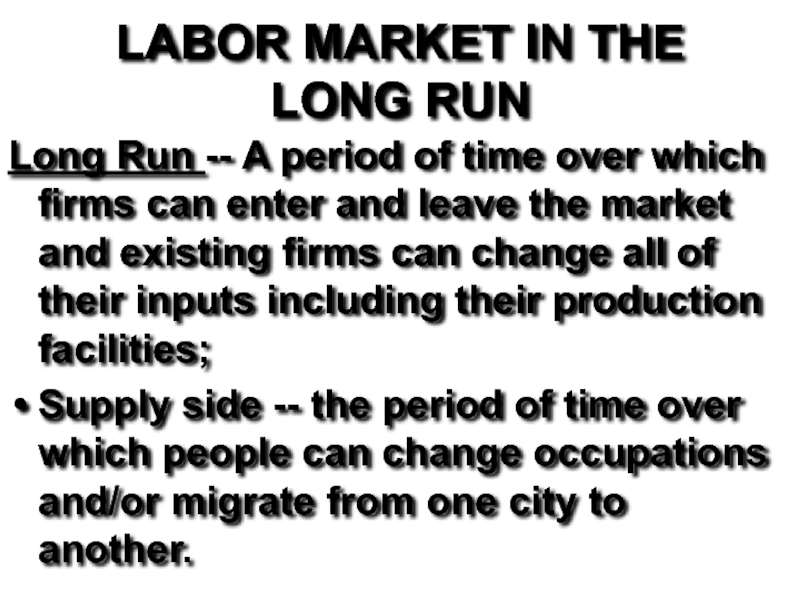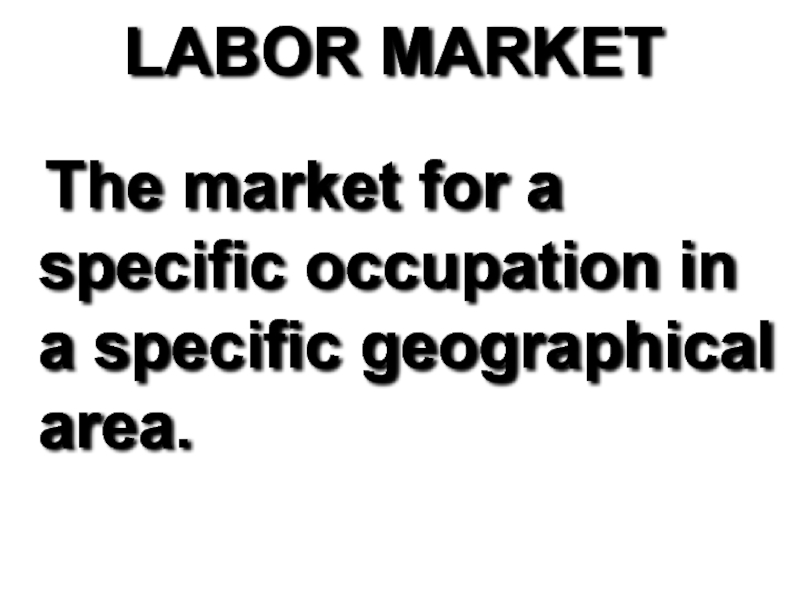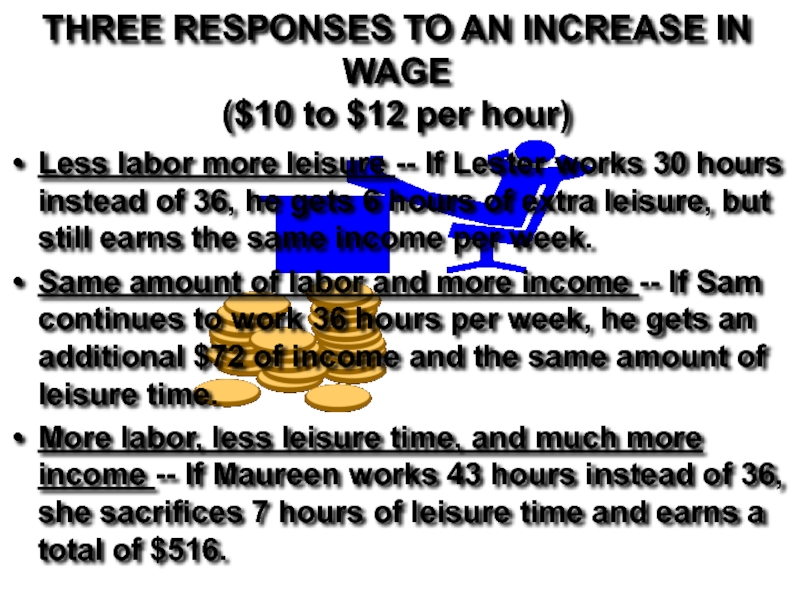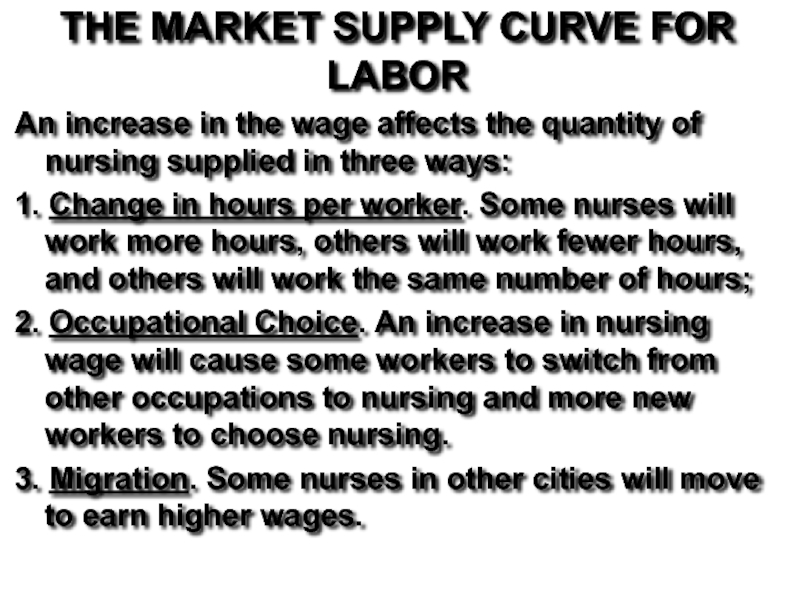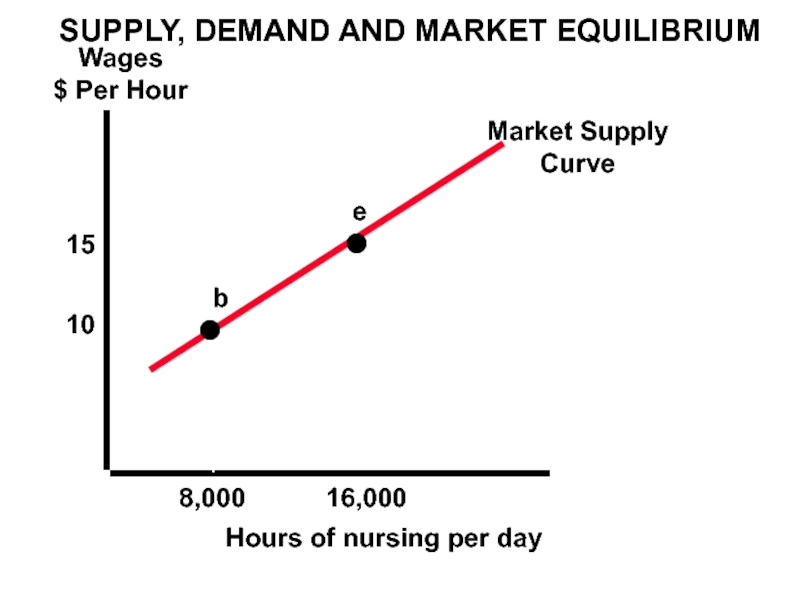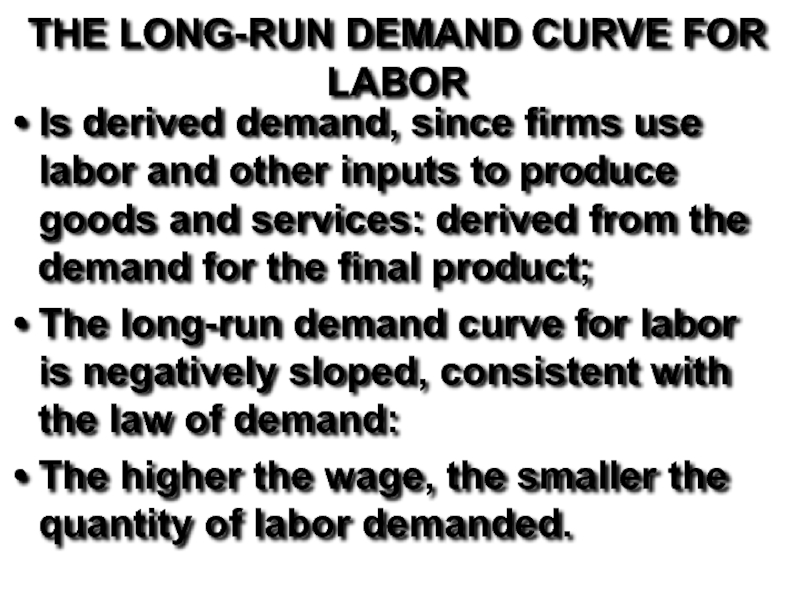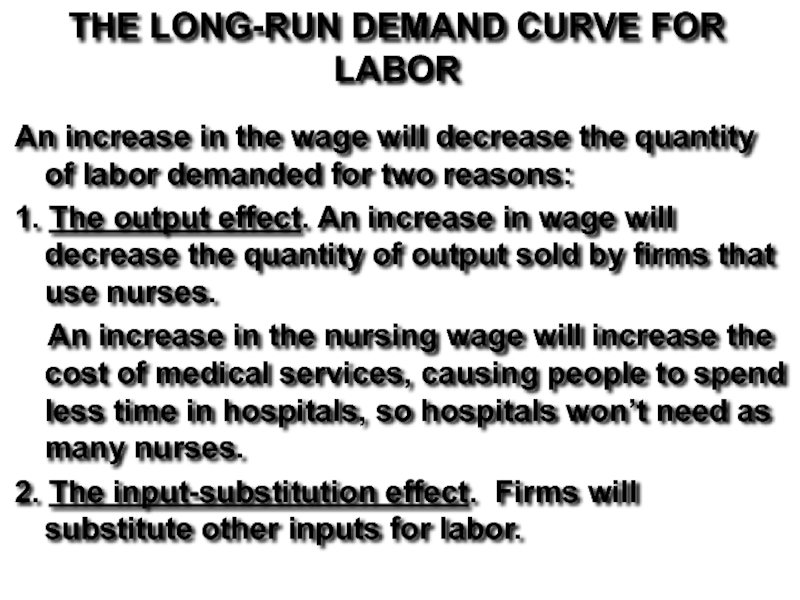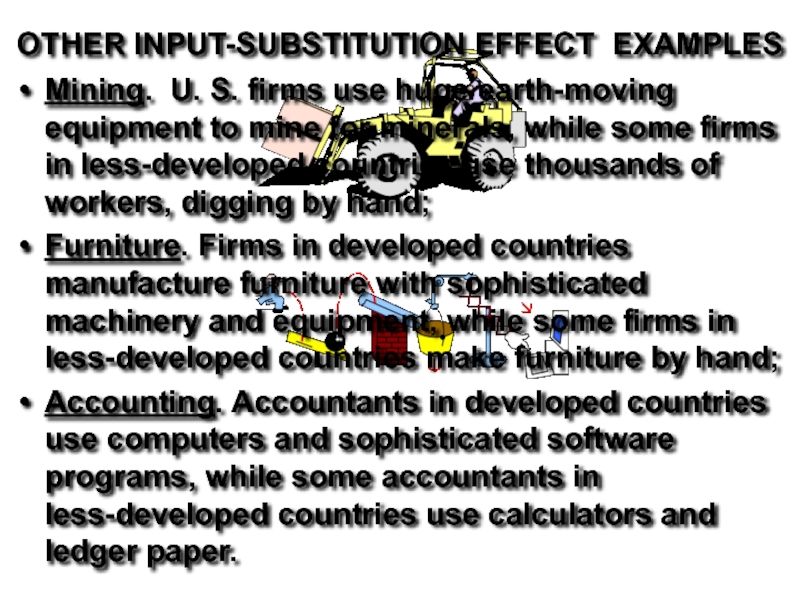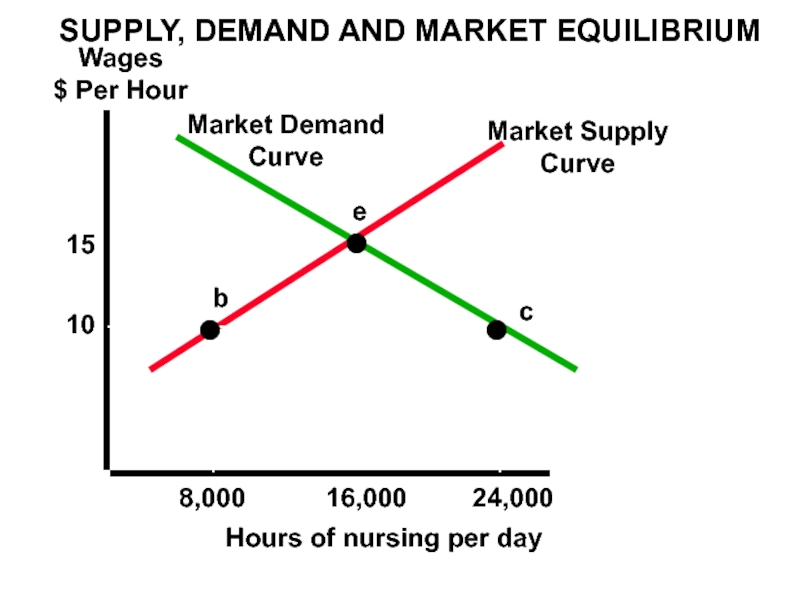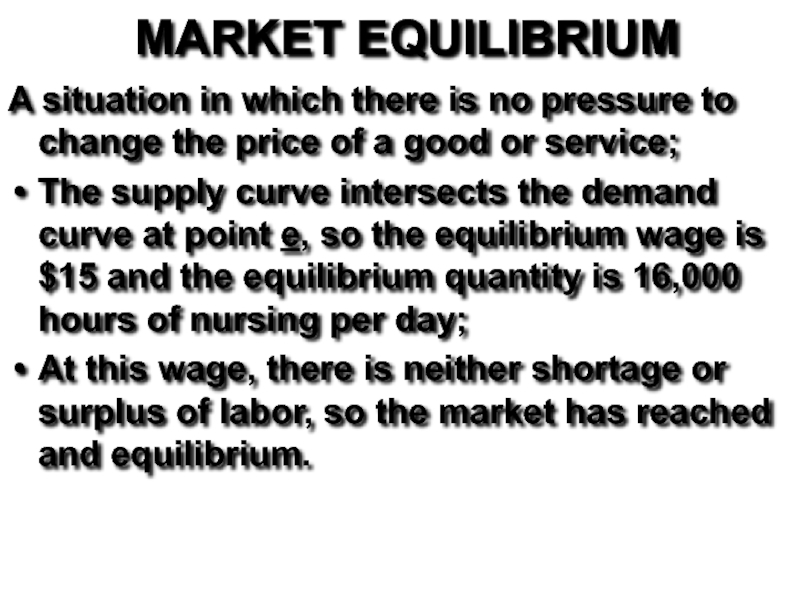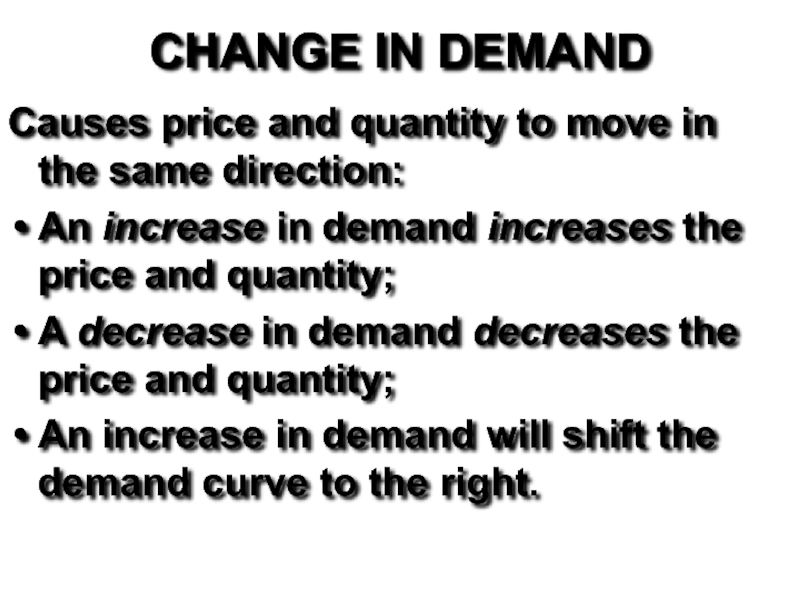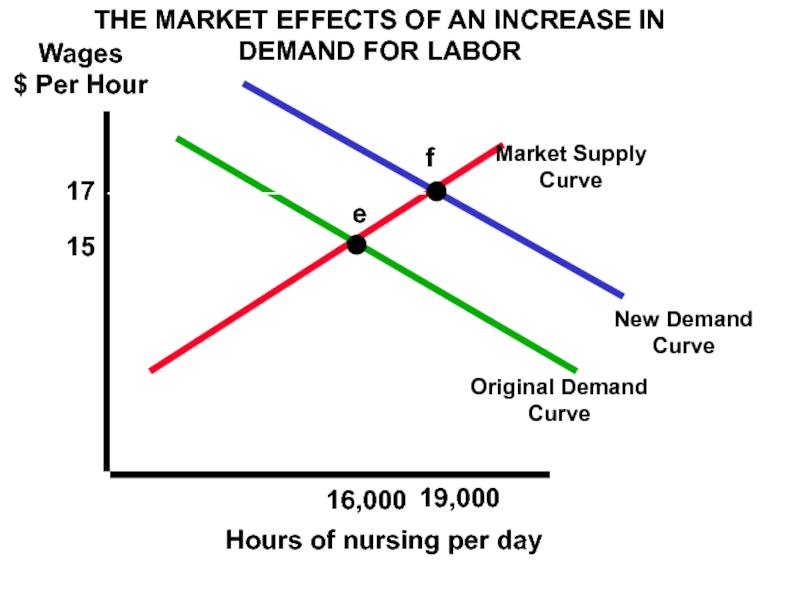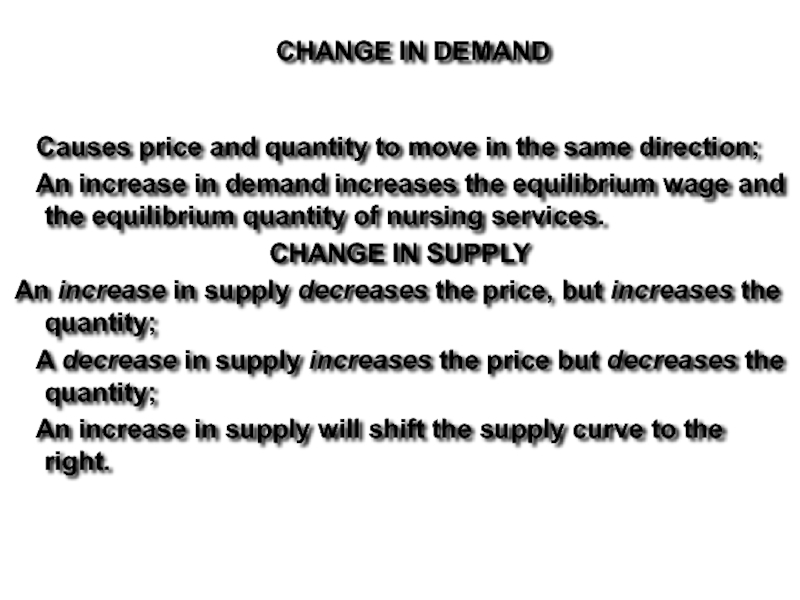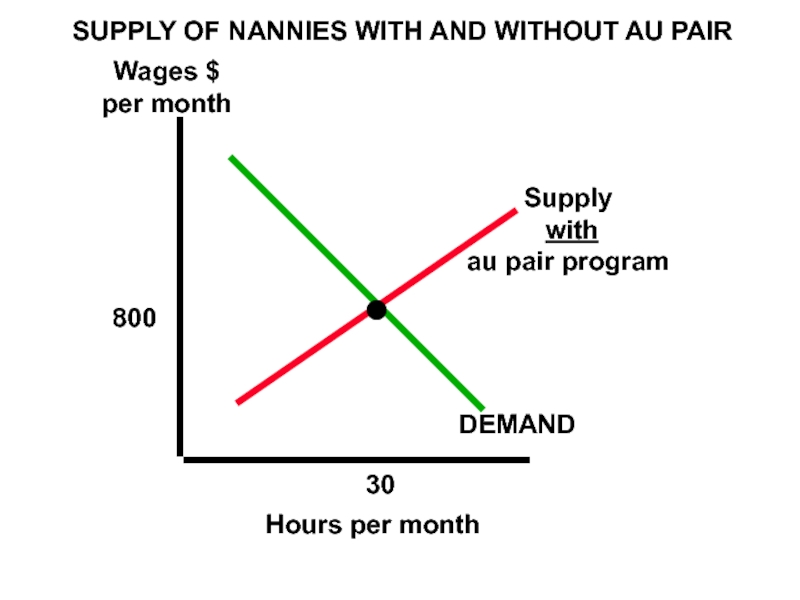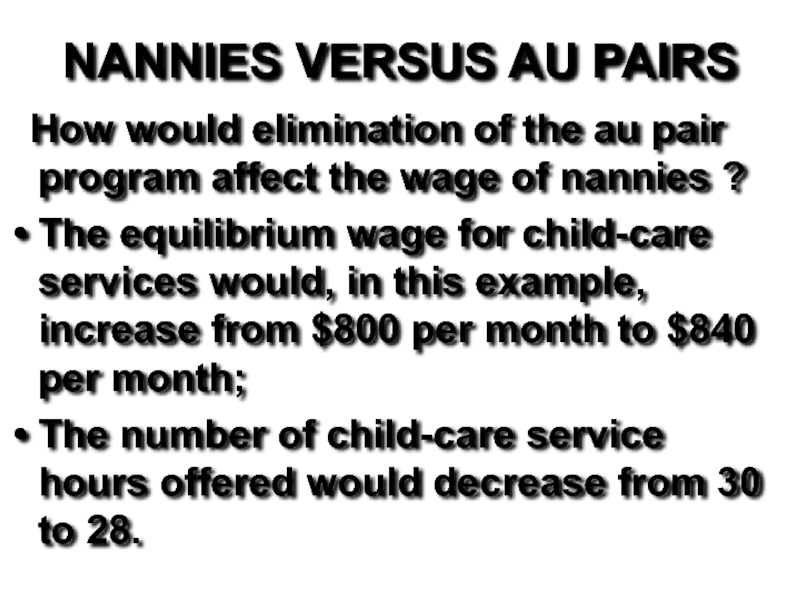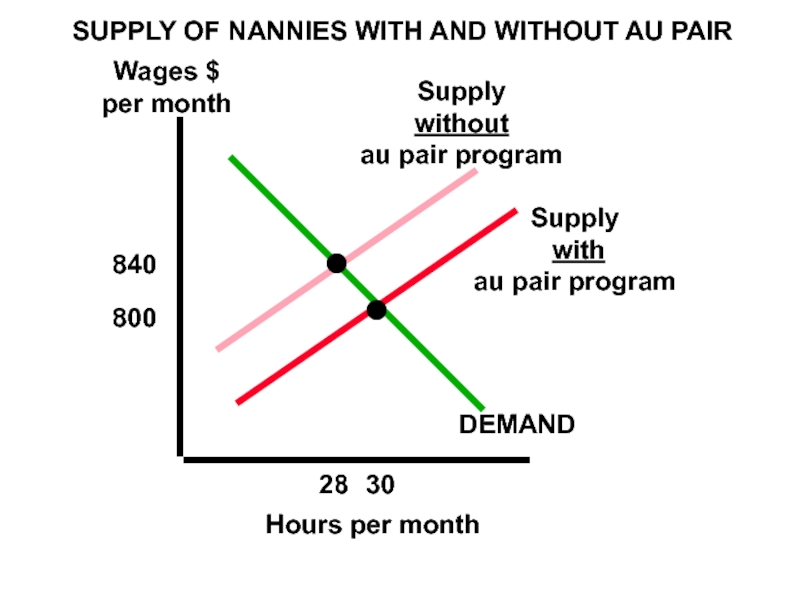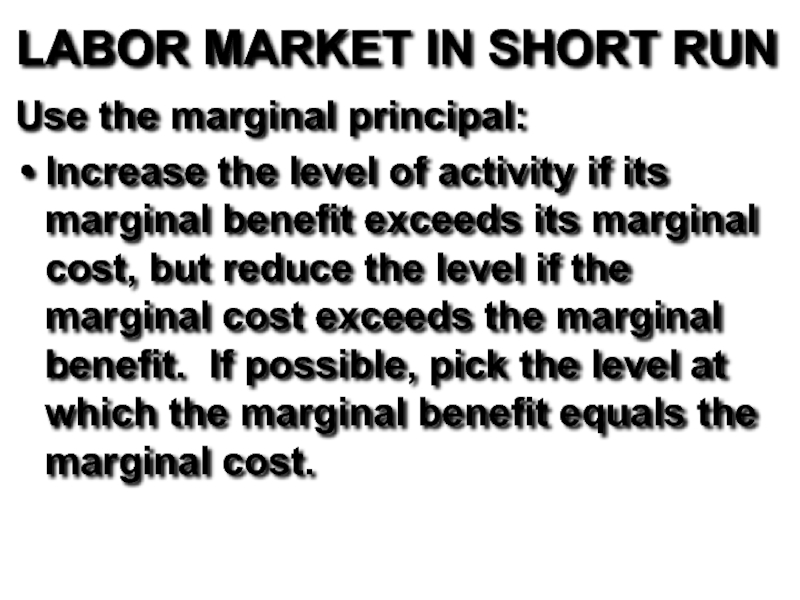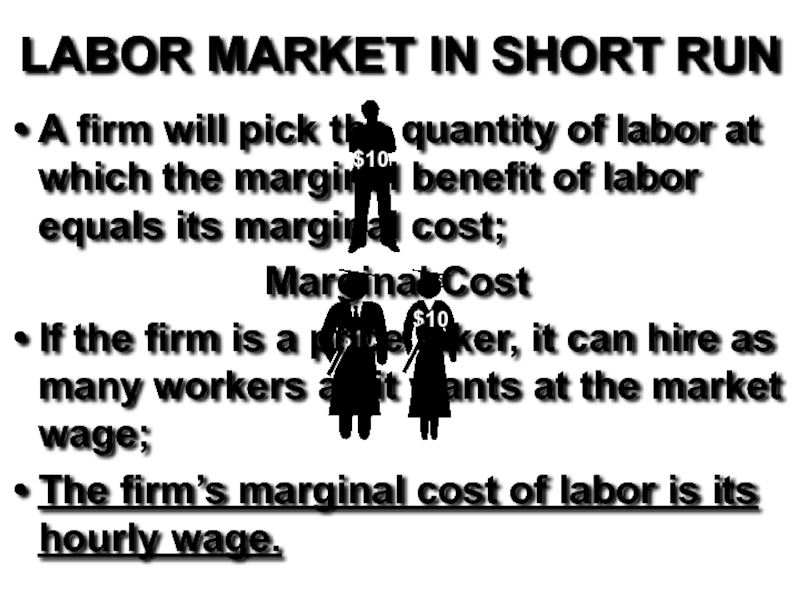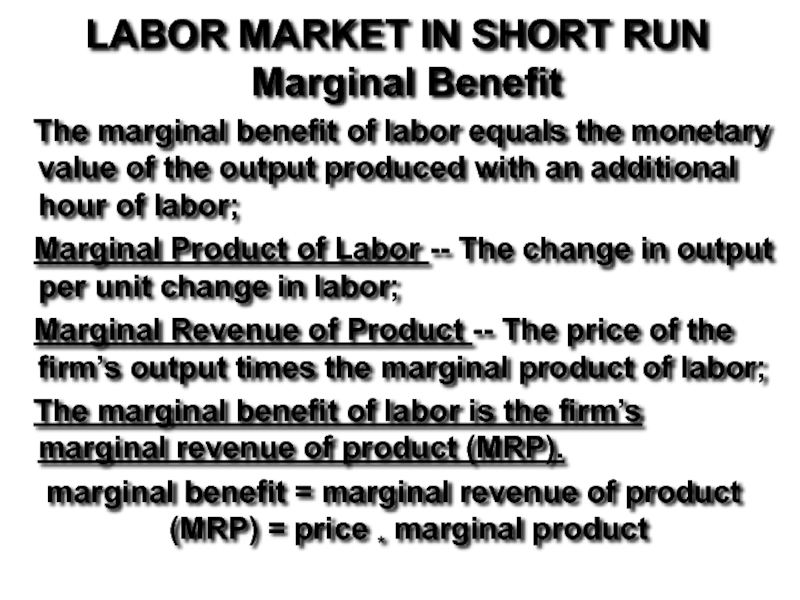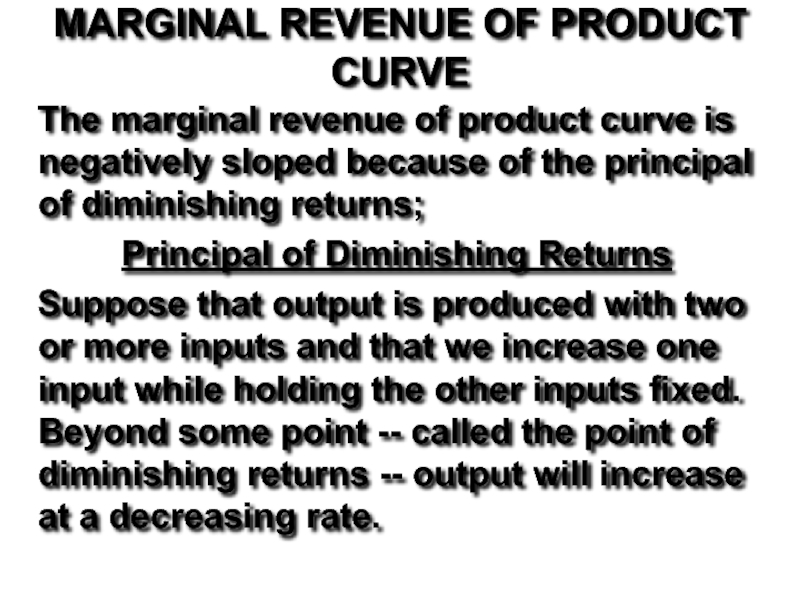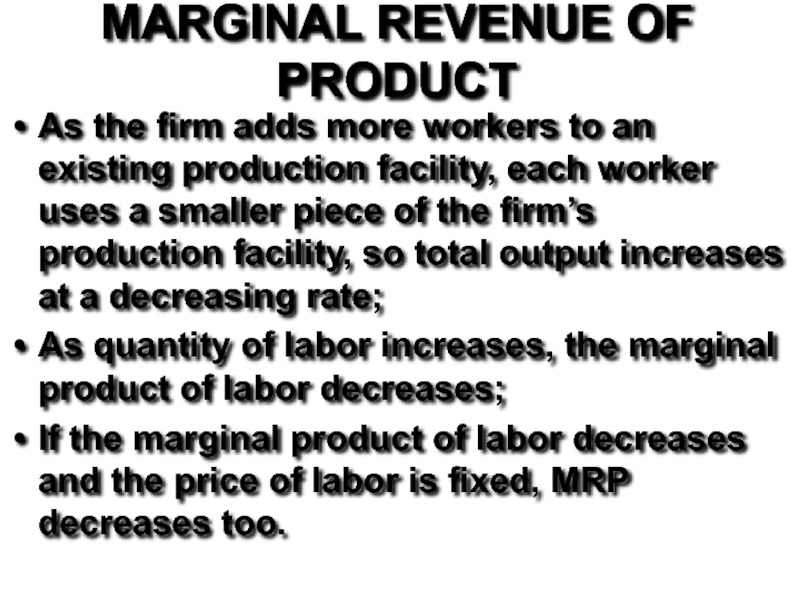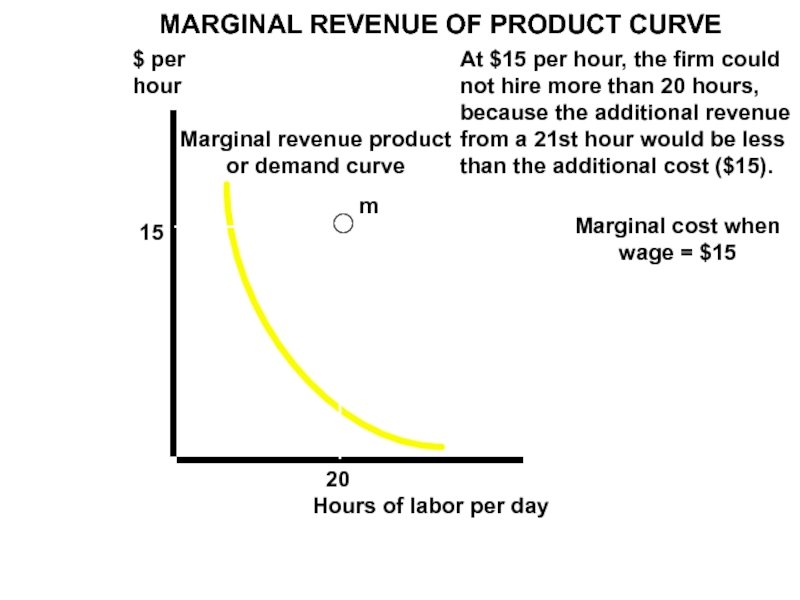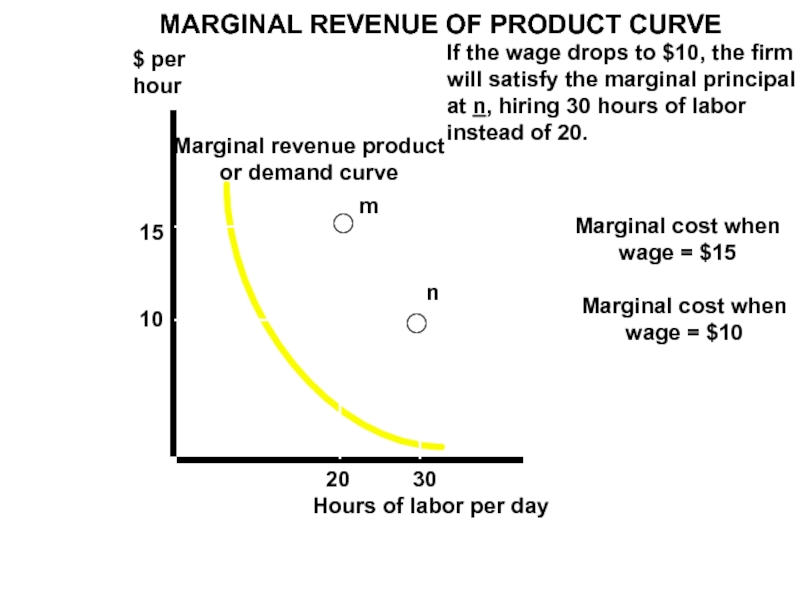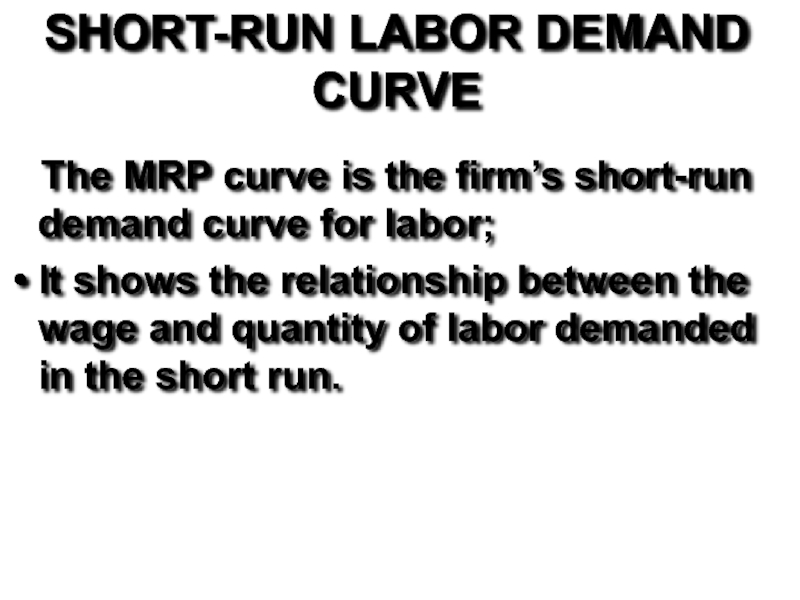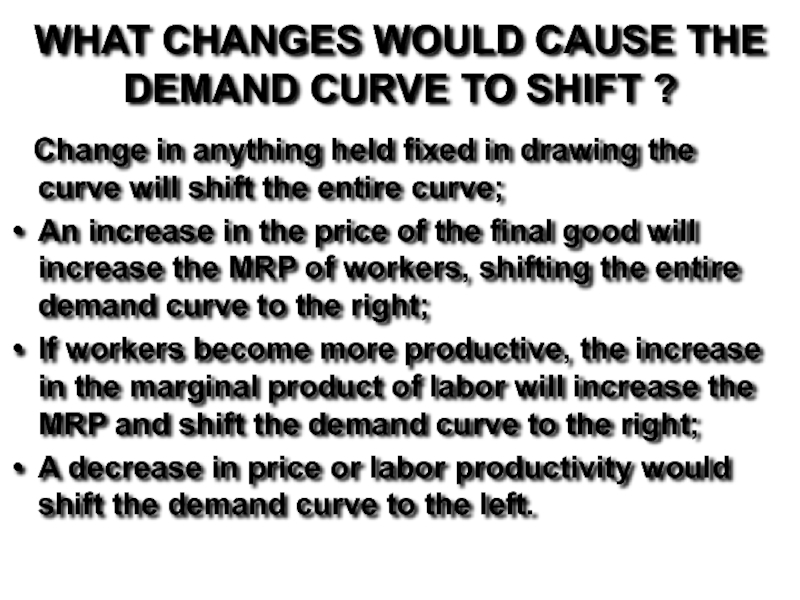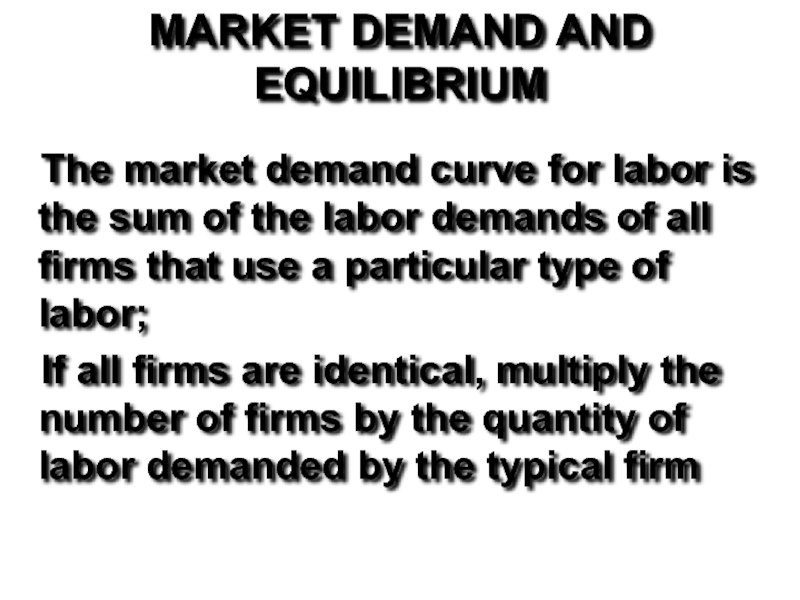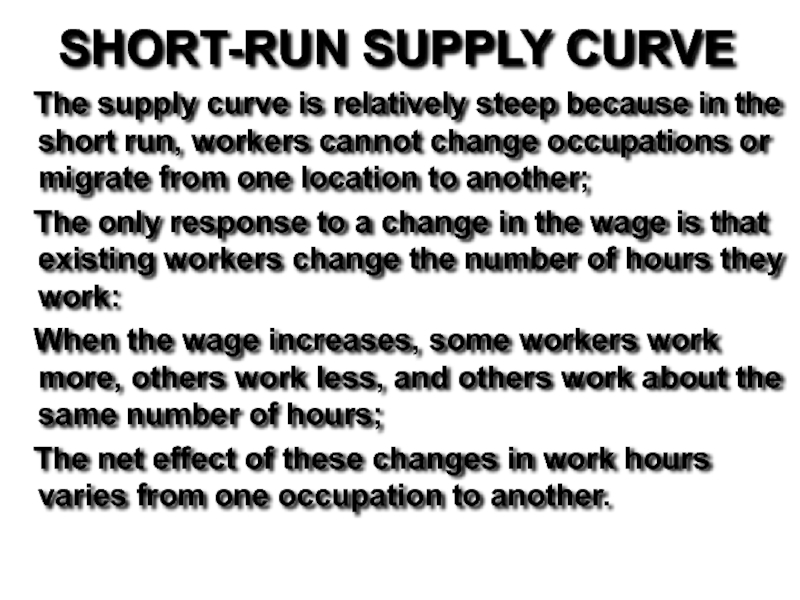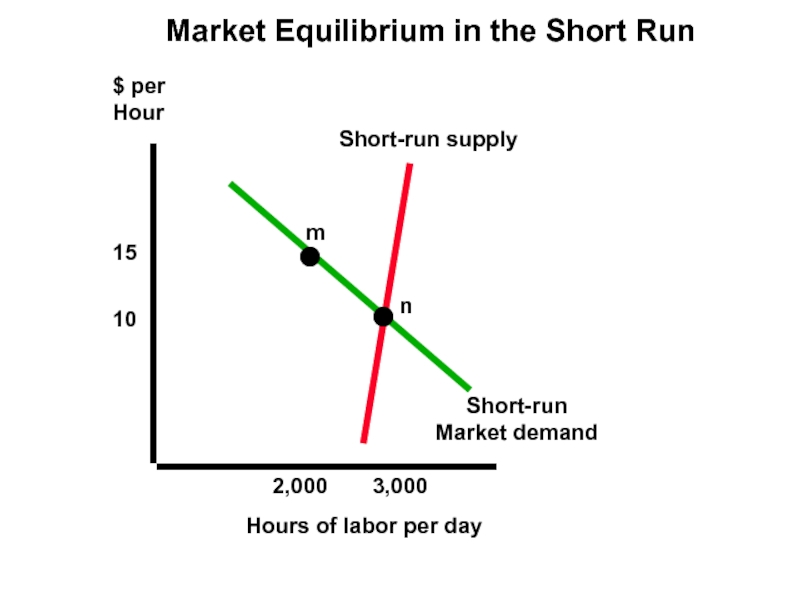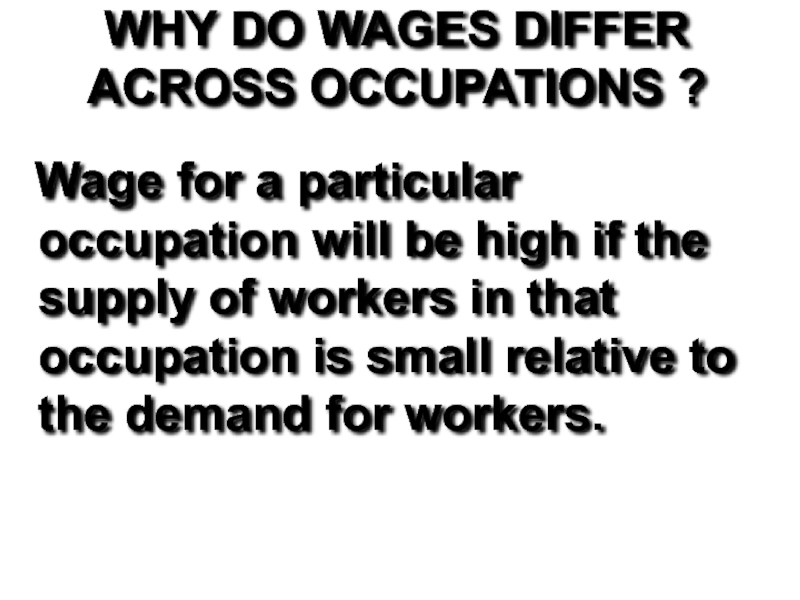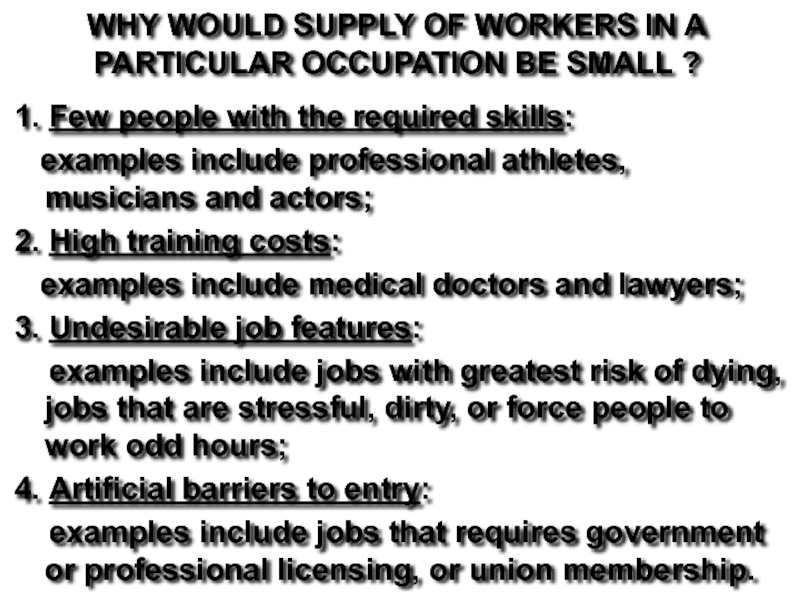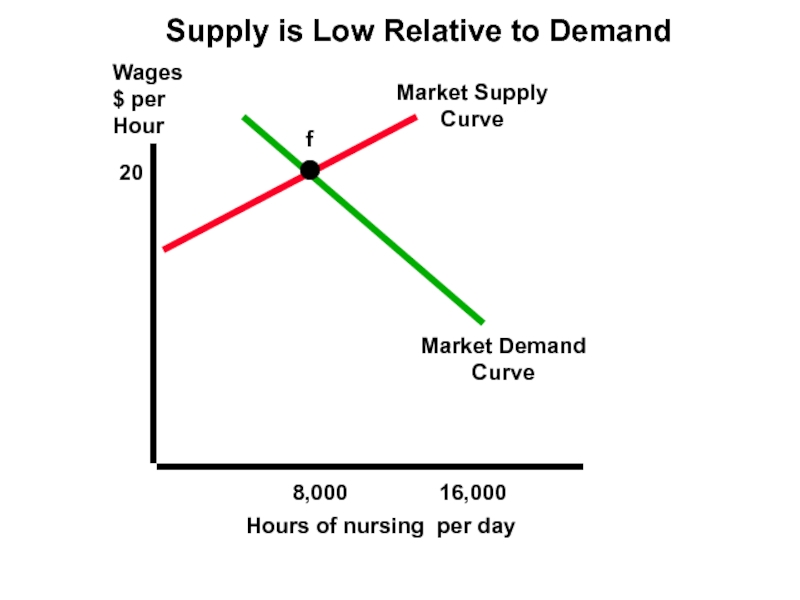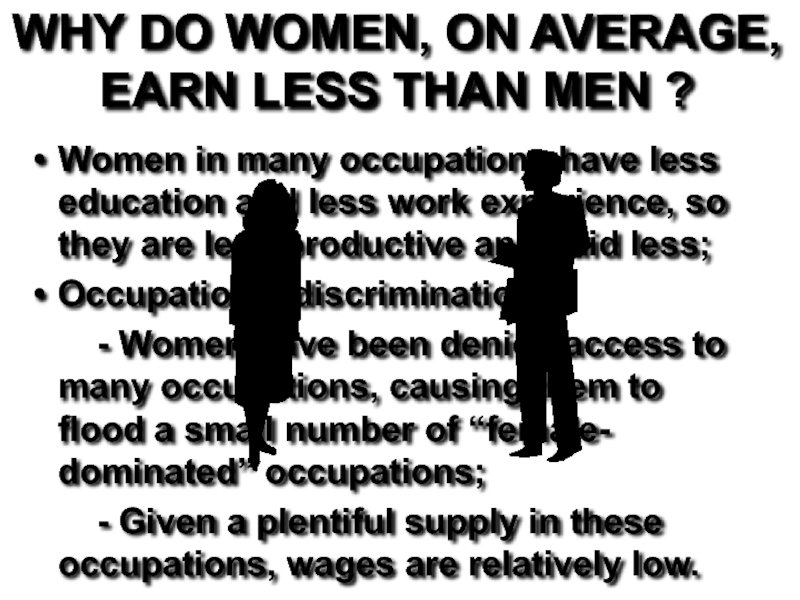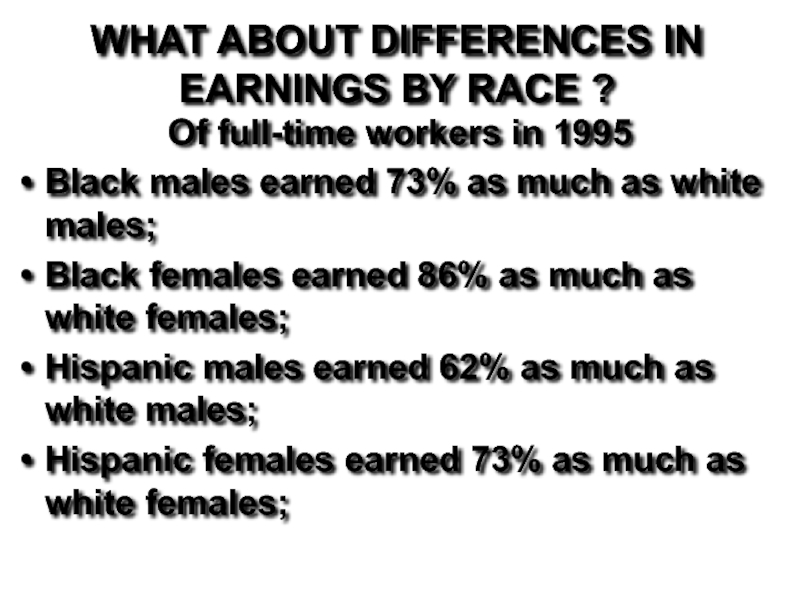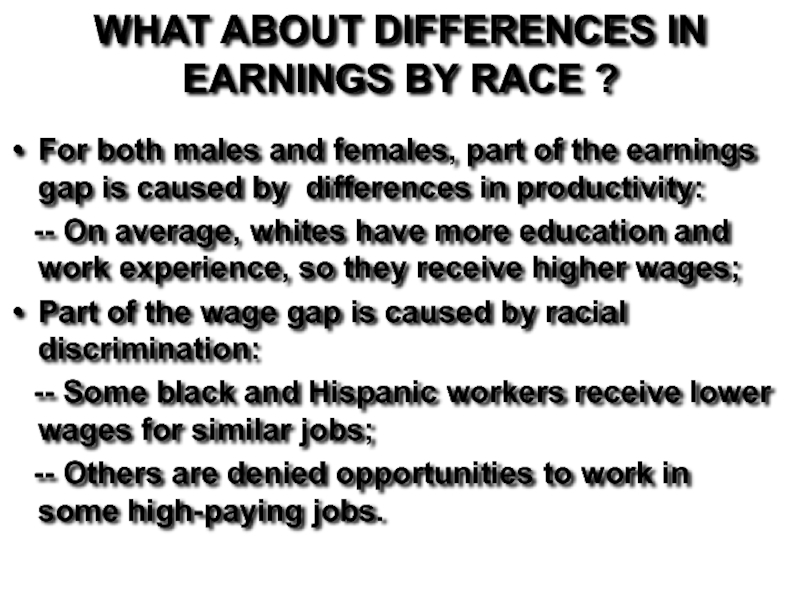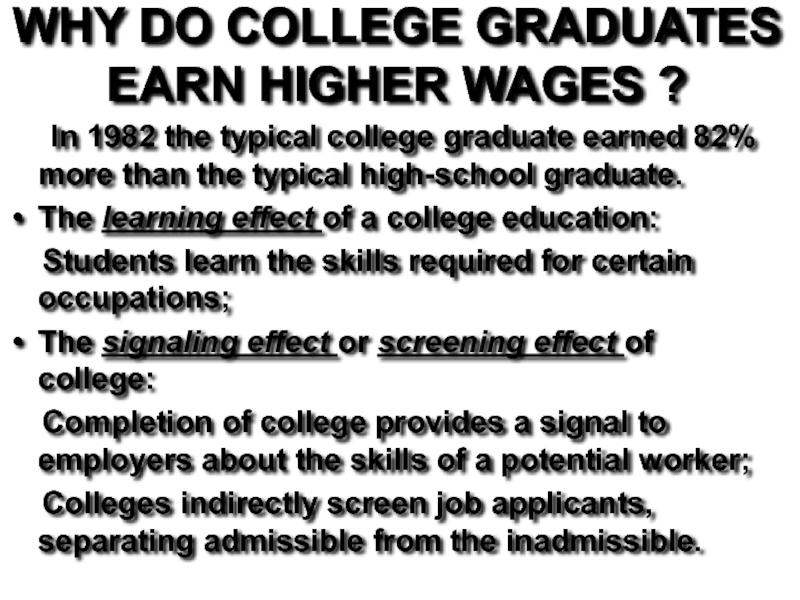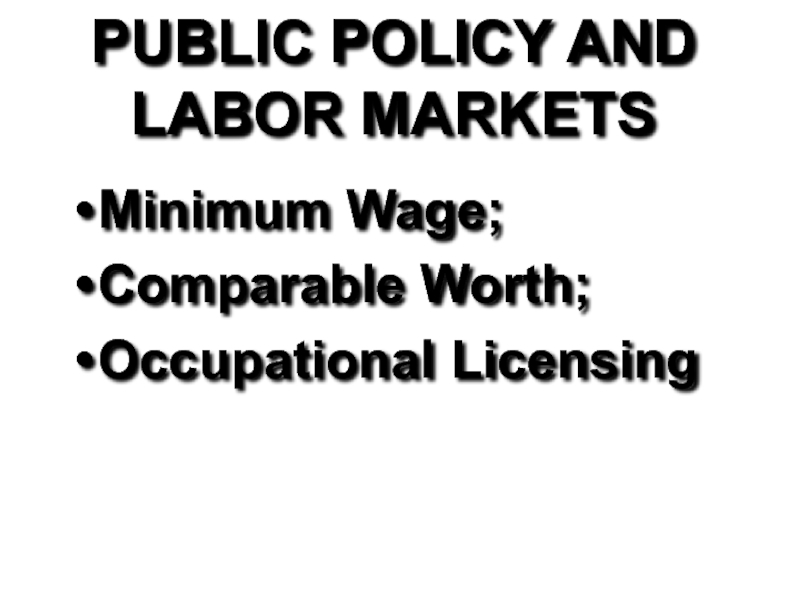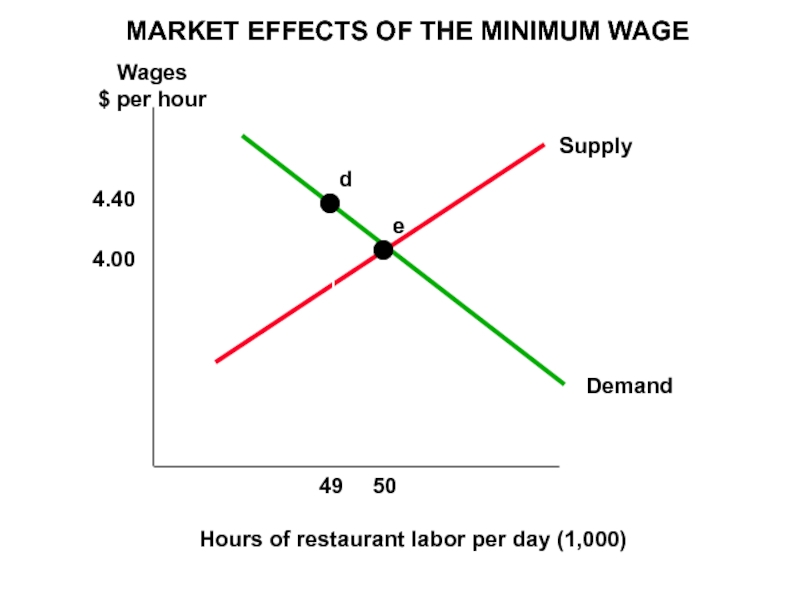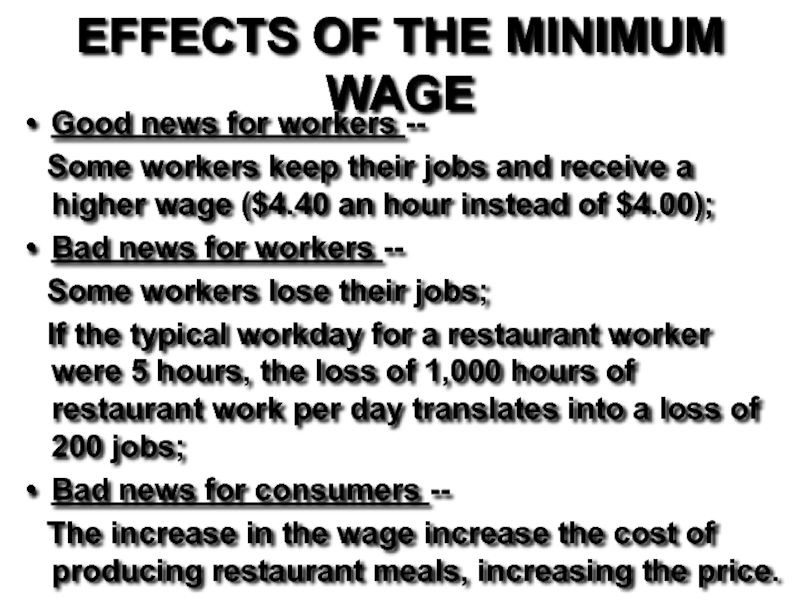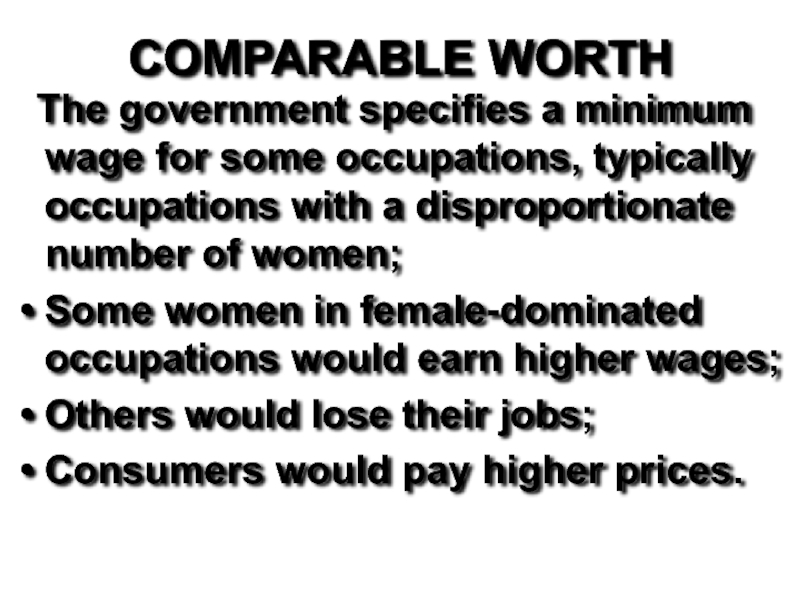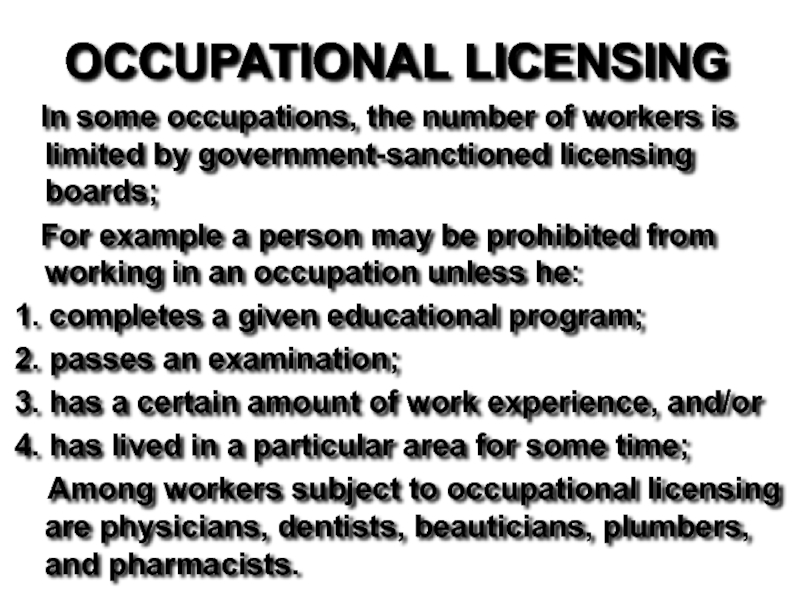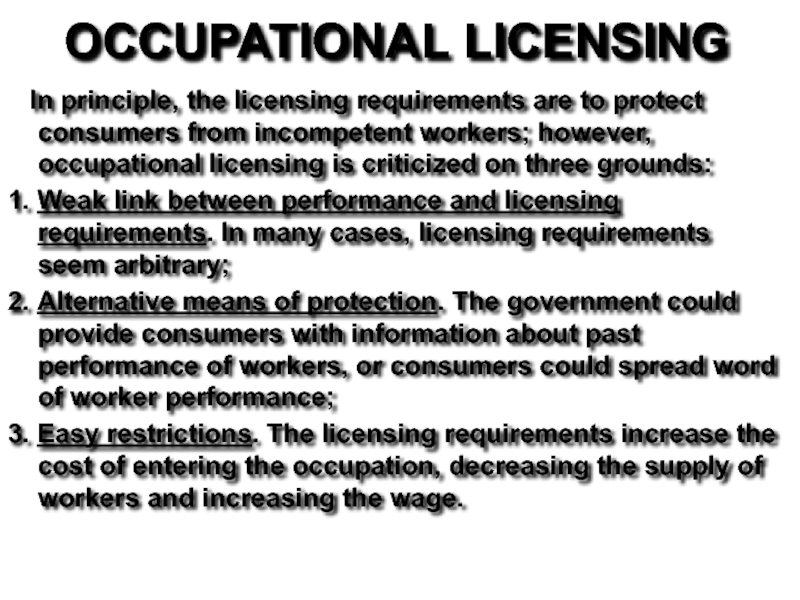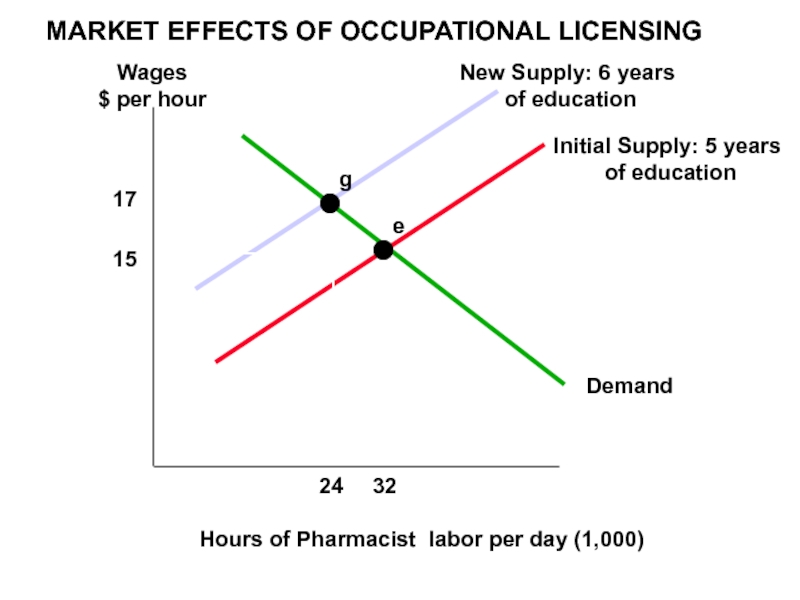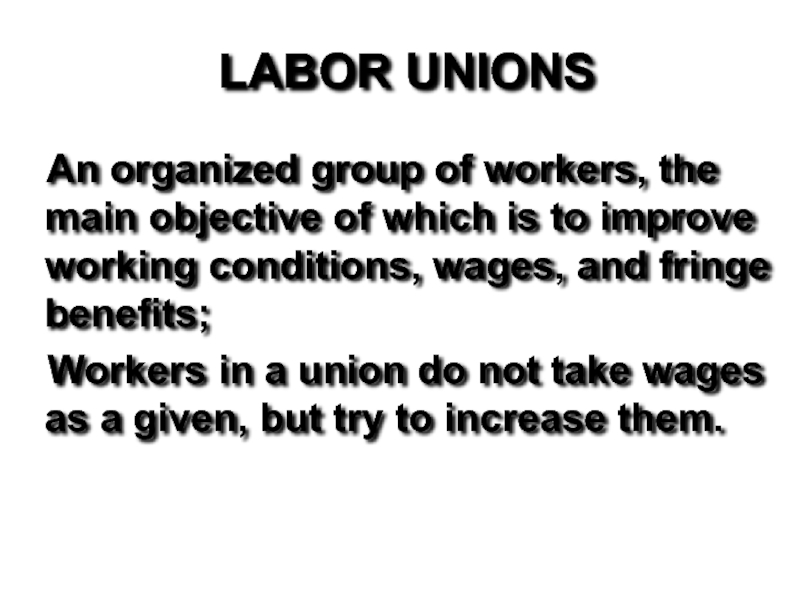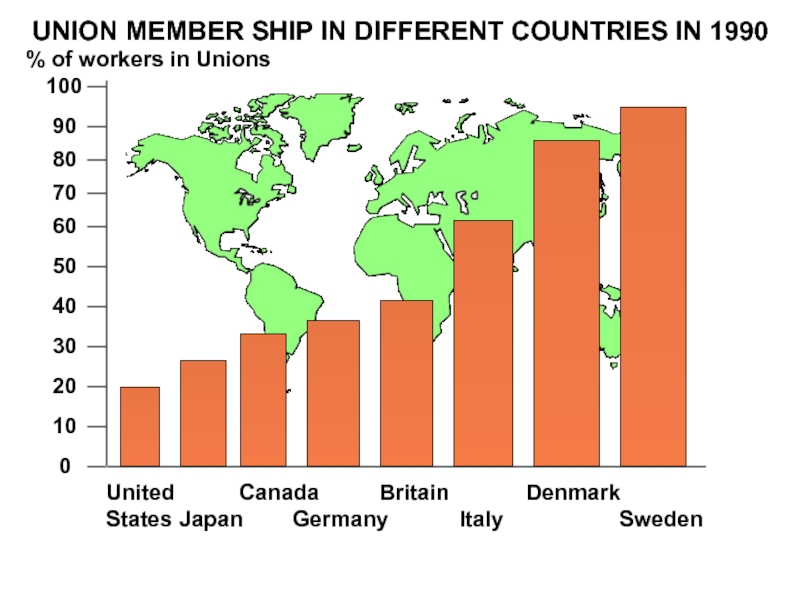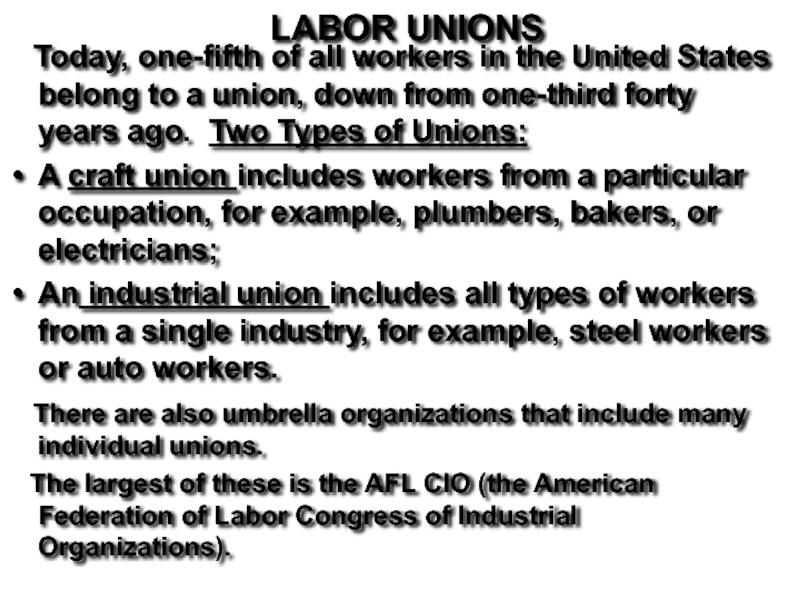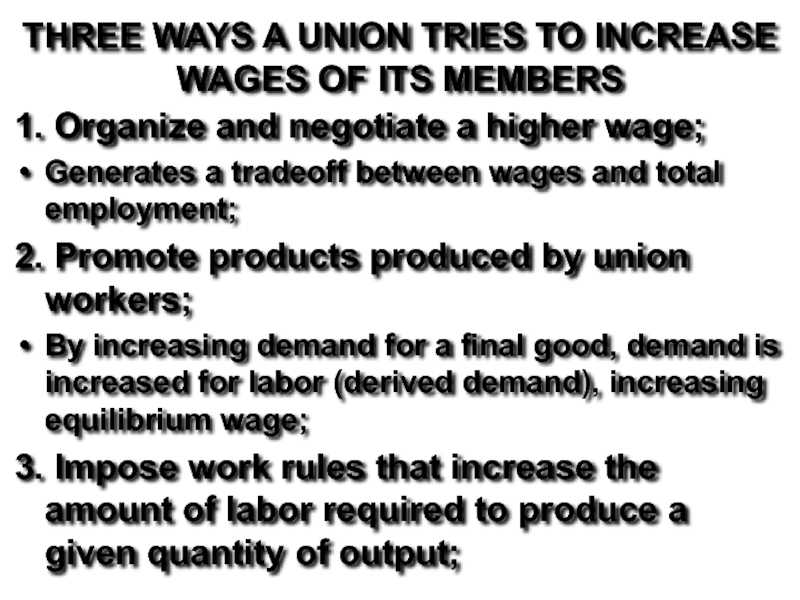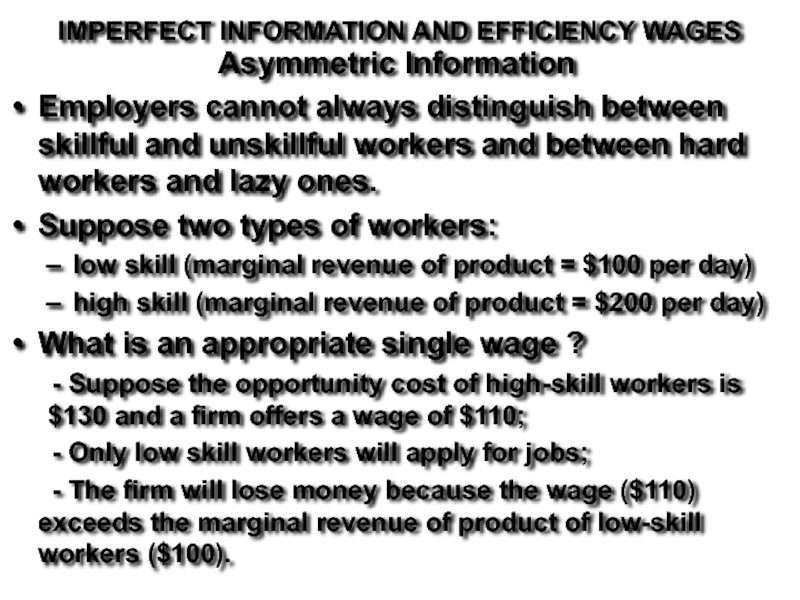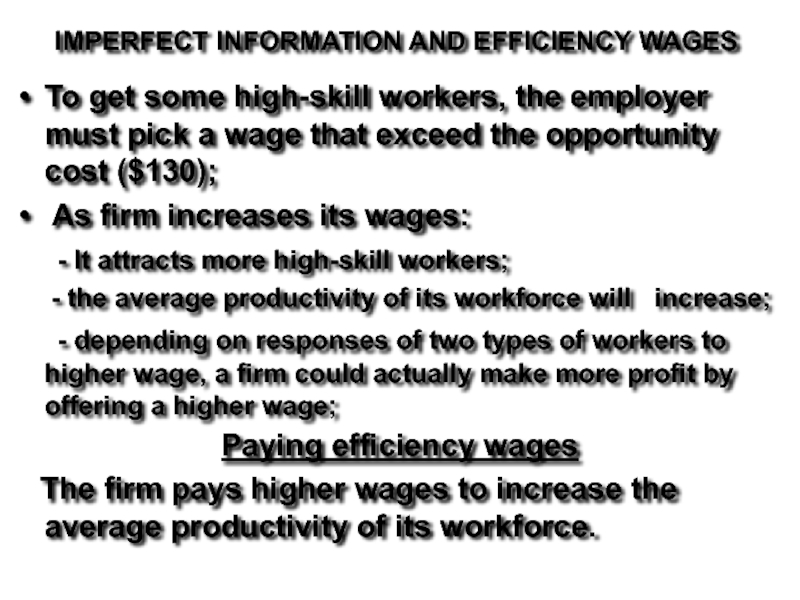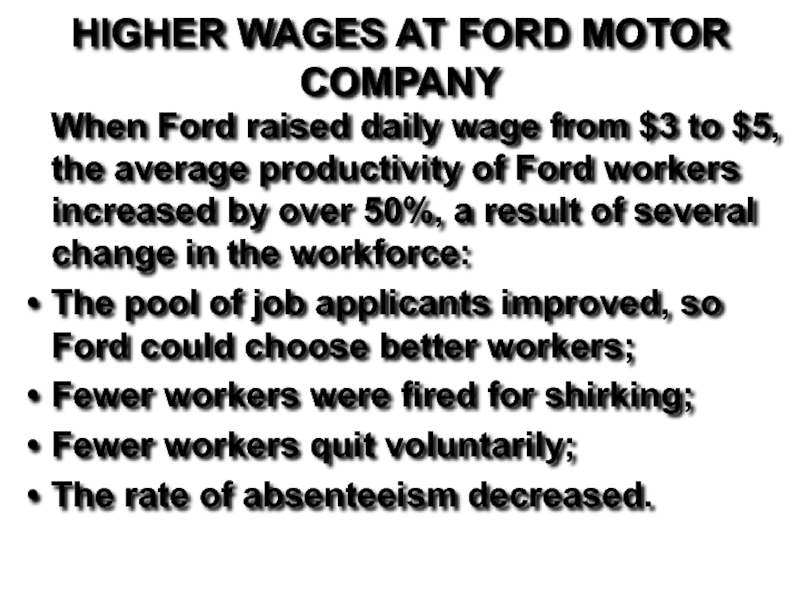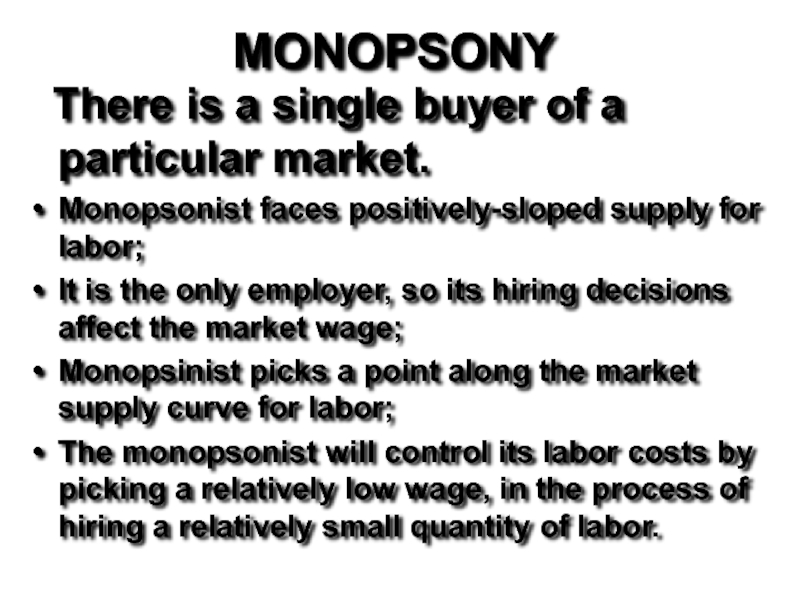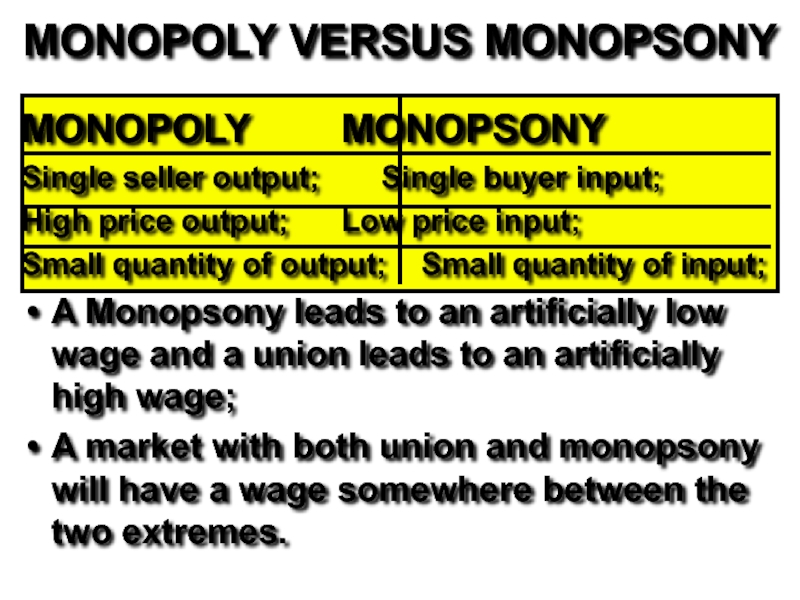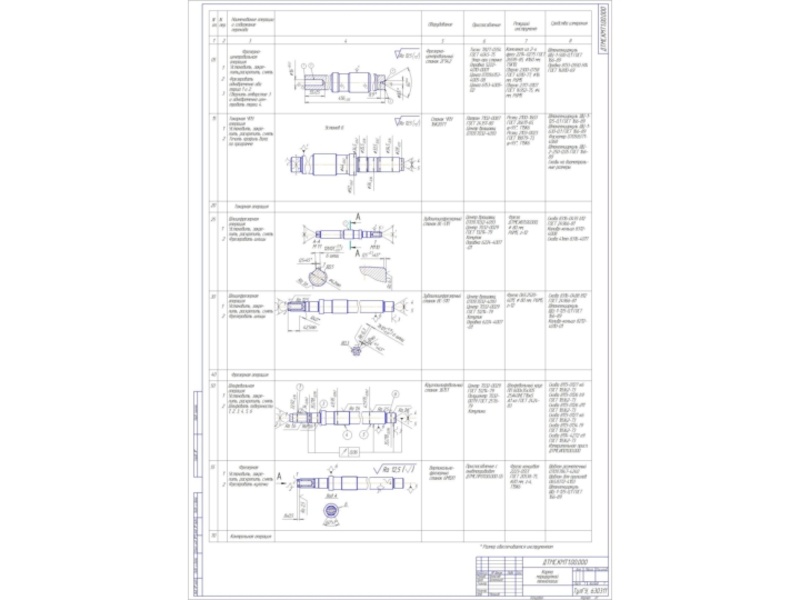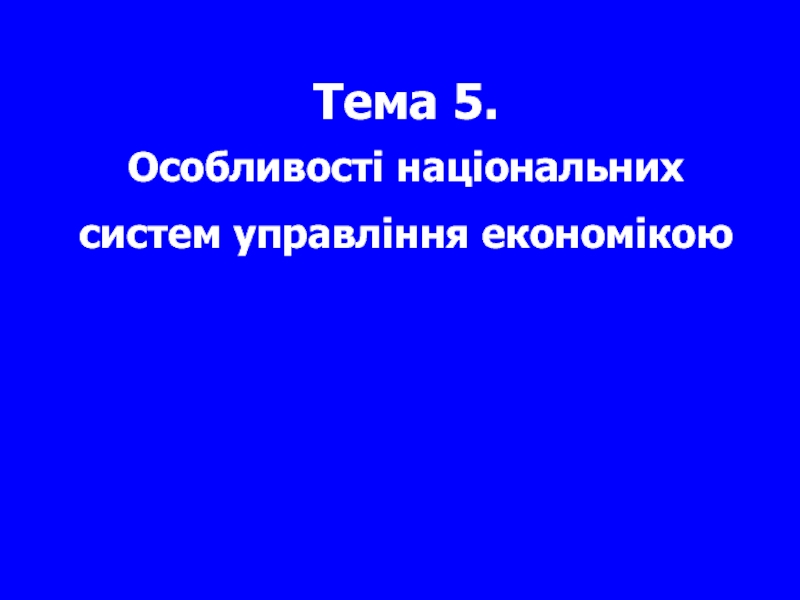- Главная
- Разное
- Дизайн
- Бизнес и предпринимательство
- Аналитика
- Образование
- Развлечения
- Красота и здоровье
- Финансы
- Государство
- Путешествия
- Спорт
- Недвижимость
- Армия
- Графика
- Культурология
- Еда и кулинария
- Лингвистика
- Английский язык
- Астрономия
- Алгебра
- Биология
- География
- Детские презентации
- Информатика
- История
- Литература
- Маркетинг
- Математика
- Медицина
- Менеджмент
- Музыка
- МХК
- Немецкий язык
- ОБЖ
- Обществознание
- Окружающий мир
- Педагогика
- Русский язык
- Технология
- Физика
- Философия
- Химия
- Шаблоны, картинки для презентаций
- Экология
- Экономика
- Юриспруденция
Labor market in the long run презентация
Содержание
- 1. Labor market in the long run
- 2. LABOR MARKET The market for a specific occupation in a specific geographical area.
- 3. Less labor more leisure -- If Lester
- 4. THE MARKET SUPPLY CURVE FOR LABOR Shows
- 5. THE MARKET SUPPLY CURVE FOR LABOR An
- 6. SUPPLY, DEMAND AND MARKET EQUILIBRIUM Wages $
- 7. THE LONG-RUN DEMAND CURVE FOR LABOR Is
- 8. THE LONG-RUN DEMAND CURVE FOR LABOR An
- 9. OTHER INPUT-SUBSTITUTION EFFECT EXAMPLES Mining. U. S.
- 10. SUPPLY, DEMAND AND MARKET EQUILIBRIUM Wages $
- 11. MARKET EQUILIBRIUM A situation in which there
- 12. CHANGE IN DEMAND Causes price and quantity
- 13. Wages $ Per Hour Hours of
- 14. CHANGE IN DEMAND Causes price
- 15. SUPPLY OF NANNIES WITH AND WITHOUT
- 16. NANNIES VERSUS AU PAIRS How would
- 17. SUPPLY OF NANNIES WITH AND
- 18. LABOR MARKET IN SHORT RUN Use the
- 19. $10 $10 $10 $10 $10 $10 $10
- 20. LABOR MARKET IN SHORT RUN
- 21. Marginal revenue product or demand curve $
- 22. MARGINAL REVENUE OF PRODUCT CURVE
- 23. MARGINAL REVENUE OF PRODUCT As the firm
- 24. Marginal revenue product or demand curve
- 25. Marginal revenue product or demand
- 26. SHORT-RUN LABOR DEMAND CURVE The
- 27. WHAT CHANGES WOULD CAUSE THE DEMAND CURVE
- 28. MARKET DEMAND AND EQUILIBRIUM The
- 29. SHORT-RUN SUPPLY CURVE The supply
- 30. $ per Hour Short-run Market demand Short-run
- 31. WHY DO WAGES DIFFER ACROSS OCCUPATIONS ?
- 32. WHY WOULD SUPPLY OF WORKERS IN A
- 33. Wages $ per Hour Market Demand Curve
- 34. WHY DO WOMEN, ON AVERAGE, EARN LESS
- 35. WHAT ABOUT DIFFERENCES IN EARNINGS BY RACE
- 36. WHAT ABOUT DIFFERENCES IN EARNINGS BY RACE
- 37. WHY DO COLLEGE GRADUATES EARN HIGHER WAGES
- 38. PUBLIC POLICY AND LABOR MARKETS Minimum Wage; Comparable Worth; Occupational Licensing
- 39. MARKET EFFECTS OF THE MINIMUM WAGE Wages
- 40. EFFECTS OF THE MINIMUM WAGE Good news
- 41. COMPARABLE WORTH The government specifies
- 42. OCCUPATIONAL LICENSING In some occupations,
- 43. OCCUPATIONAL LICENSING In principle, the
- 44. MARKET EFFECTS OF OCCUPATIONAL LICENSING Wages $
- 45. LABOR UNIONS An organized group
- 46. UNION MEMBER SHIP IN DIFFERENT COUNTRIES IN
- 47. Today, one-fifth of all workers
- 48. THREE WAYS A UNION TRIES TO INCREASE
- 49. IMPERFECT INFORMATION AND EFFICIENCY WAGES Asymmetric Information
- 50. IMPERFECT INFORMATION AND EFFICIENCY WAGES To get
- 51. HIGHER WAGES AT FORD MOTOR COMPANY
- 52. MONOPSONY There is a single buyer
- 53. MONOPOLY VERSUS MONOPSONY MONOPOLY MONOPSONY Single seller
Слайд 1LABOR MARKET IN THE LONG RUN
Long Run -- A period of
Supply side -- the period of time over which people can change occupations and/or migrate from one city to another.
Слайд 3Less labor more leisure -- If Lester works 30 hours instead
Same amount of labor and more income -- If Sam continues to work 36 hours per week, he gets an additional $72 of income and the same amount of leisure time.
More labor, less leisure time, and much more income -- If Maureen works 43 hours instead of 36, she sacrifices 7 hours of leisure time and earns a total of $516.
THREE RESPONSES TO AN INCREASE IN WAGE
($10 to $12 per hour)
Слайд 4THE MARKET SUPPLY CURVE FOR LABOR
Shows the relationship between the wage
The market supply is positively sloped, consistent with the law of supply:
The higher the wage (price of labor) the larger the quantity supplied
Слайд 5THE MARKET SUPPLY CURVE FOR LABOR
An increase in the wage affects
1. Change in hours per worker. Some nurses will work more hours, others will work fewer hours, and others will work the same number of hours;
2. Occupational Choice. An increase in nursing wage will cause some workers to switch from other occupations to nursing and more new workers to choose nursing.
3. Migration. Some nurses in other cities will move to earn higher wages.
Слайд 6SUPPLY, DEMAND AND MARKET EQUILIBRIUM
Wages
$ Per Hour
Hours of nursing per day
15
10
8,000
16,000
b
e
Market
Curve
Слайд 7THE LONG-RUN DEMAND CURVE FOR LABOR
Is derived demand, since firms use
The long-run demand curve for labor is negatively sloped, consistent with the law of demand:
The higher the wage, the smaller the quantity of labor demanded.
Слайд 8THE LONG-RUN DEMAND CURVE FOR LABOR
An increase in the wage will
1. The output effect. An increase in wage will decrease the quantity of output sold by firms that use nurses.
An increase in the nursing wage will increase the cost of medical services, causing people to spend less time in hospitals, so hospitals won’t need as many nurses.
2. The input-substitution effect. Firms will substitute other inputs for labor.
Слайд 9OTHER INPUT-SUBSTITUTION EFFECT EXAMPLES
Mining. U. S. firms use huge earth-moving equipment
Furniture. Firms in developed countries manufacture furniture with sophisticated machinery and equipment, while some firms in less-developed countries make furniture by hand;
Accounting. Accountants in developed countries use computers and sophisticated software programs, while some accountants in less-developed countries use calculators and ledger paper.
Слайд 10SUPPLY, DEMAND AND MARKET EQUILIBRIUM
Wages
$ Per Hour
Hours of nursing per day
15
10
8,000
16,000
24,000
b
e
c
Market
Curve
Market Supply
Curve
Слайд 11MARKET EQUILIBRIUM
A situation in which there is no pressure to change
The supply curve intersects the demand curve at point e, so the equilibrium wage is $15 and the equilibrium quantity is 16,000 hours of nursing per day;
At this wage, there is neither shortage or surplus of labor, so the market has reached and equilibrium.
Слайд 12CHANGE IN DEMAND
Causes price and quantity to move in the same
An increase in demand increases the price and quantity;
A decrease in demand decreases the price and quantity;
An increase in demand will shift the demand curve to the right.
Слайд 13Wages
$ Per Hour
Hours of nursing per day
15
16,000
e
Original Demand
Curve
Market Supply
Curve
THE MARKET EFFECTS
DEMAND FOR LABOR
f
17
19,000
New Demand
Curve
Слайд 14CHANGE IN DEMAND
Causes price and quantity to move in
An increase in demand increases the equilibrium wage and the equilibrium quantity of nursing services.
CHANGE IN SUPPLY
An increase in supply decreases the price, but increases the quantity;
A decrease in supply increases the price but decreases the quantity;
An increase in supply will shift the supply curve to the right.
Слайд 15
SUPPLY OF NANNIES WITH AND WITHOUT AU PAIR
Wages $
per month
800
30
DEMAND
Hours
Supply
with
au pair program
Слайд 16NANNIES VERSUS AU PAIRS
How would elimination of the au pair
The equilibrium wage for child-care services would, in this example, increase from $800 per month to $840 per month;
The number of child-care service hours offered would decrease from 30 to 28.
Слайд 17
SUPPLY OF NANNIES WITH AND WITHOUT AU PAIR
Wages $
per month
840
800
28
30
DEMAND
Hours
Supply
without
au pair program
Supply
with
au pair program
Слайд 18LABOR MARKET IN SHORT RUN
Use the marginal principal:
Increase the level of
Слайд 19$10
$10
$10
$10
$10
$10
$10
$10
$10
$10
LABOR MARKET IN SHORT RUN
A firm will pick the quantity of
Marginal Cost
If the firm is a price taker, it can hire as many workers as it wants at the market wage;
The firm’s marginal cost of labor is its hourly wage.
Слайд 20LABOR MARKET IN SHORT RUN
Marginal Benefit
The marginal
Marginal Product of Labor -- The change in output per unit change in labor;
Marginal Revenue of Product -- The price of the firm’s output times the marginal product of labor;
The marginal benefit of labor is the firm’s marginal revenue of product (MRP).
marginal benefit = marginal revenue of product (MRP) = price * marginal product
Слайд 21Marginal revenue product
or demand curve
$ per
hour
Hours of labor per day
MARGINAL REVENUE
Слайд 22MARGINAL REVENUE OF PRODUCT CURVE
The marginal revenue of product
Principal of Diminishing Returns
Suppose that output is produced with two or more inputs and that we increase one input while holding the other inputs fixed. Beyond some point -- called the point of diminishing returns -- output will increase at a decreasing rate.
Слайд 23MARGINAL REVENUE OF PRODUCT
As the firm adds more workers to an
As quantity of labor increases, the marginal product of labor decreases;
If the marginal product of labor decreases and the price of labor is fixed, MRP decreases too.
Слайд 24
Marginal revenue product
or demand curve
Marginal cost when
wage = $15
$ per
hour
Hours
15
20
MARGINAL REVENUE OF PRODUCT CURVE
m
At $15 per hour, the firm could
not hire more than 20 hours,
because the additional revenue
from a 21st hour would be less
than the additional cost ($15).
Слайд 25
Marginal revenue product
or demand curve
Marginal cost when
wage = $15
$ per
hour
Hours
15
10
20
30
Marginal cost when
wage = $10
MARGINAL REVENUE OF PRODUCT CURVE
m
n
If the wage drops to $10, the firm
will satisfy the marginal principal
at n, hiring 30 hours of labor
instead of 20.
Слайд 26SHORT-RUN LABOR DEMAND CURVE
The MRP curve is the firm’s
It shows the relationship between the wage and quantity of labor demanded in the short run.
Слайд 27WHAT CHANGES WOULD CAUSE THE DEMAND CURVE TO SHIFT ?
An increase in the price of the final good will increase the MRP of workers, shifting the entire demand curve to the right;
If workers become more productive, the increase in the marginal product of labor will increase the MRP and shift the demand curve to the right;
A decrease in price or labor productivity would shift the demand curve to the left.
Слайд 28MARKET DEMAND AND EQUILIBRIUM
The market demand curve for labor
If all firms are identical, multiply the number of firms by the quantity of labor demanded by the typical firm
Слайд 29SHORT-RUN SUPPLY CURVE
The supply curve is relatively steep because
The only response to a change in the wage is that existing workers change the number of hours they work:
When the wage increases, some workers work more, others work less, and others work about the same number of hours;
The net effect of these changes in work hours varies from one occupation to another.
Слайд 30$ per
Hour
Short-run
Market demand
Short-run supply
Hours of labor per day
15
10
2,000
3,000
m
n
Market Equilibrium in the
Слайд 31WHY DO WAGES DIFFER ACROSS OCCUPATIONS ?
Wage for a particular
Слайд 32WHY WOULD SUPPLY OF WORKERS IN A PARTICULAR OCCUPATION BE SMALL
1. Few people with the required skills:
examples include professional athletes, musicians and actors;
2. High training costs:
examples include medical doctors and lawyers;
3. Undesirable job features:
examples include jobs with greatest risk of dying, jobs that are stressful, dirty, or force people to work odd hours;
4. Artificial barriers to entry:
examples include jobs that requires government or professional licensing, or union membership.
Слайд 33Wages
$ per
Hour
Market Demand
Curve
Market Supply
Curve
Hours of nursing per day
Supply is Low
20
8,000
16,000
f
Слайд 34WHY DO WOMEN, ON AVERAGE, EARN LESS THAN MEN ?
Women in
Occupational discrimination:
- Women have been denied access to many occupations, causing them to flood a small number of “female- dominated” occupations;
- Given a plentiful supply in these occupations, wages are relatively low.
Слайд 35WHAT ABOUT DIFFERENCES IN EARNINGS BY RACE ?
Of full-time workers in
Black males earned 73% as much as white males;
Black females earned 86% as much as white females;
Hispanic males earned 62% as much as white males;
Hispanic females earned 73% as much as white females;
Слайд 36WHAT ABOUT DIFFERENCES IN EARNINGS BY RACE ?
For both males and
-- On average, whites have more education and work experience, so they receive higher wages;
Part of the wage gap is caused by racial discrimination:
-- Some black and Hispanic workers receive lower wages for similar jobs;
-- Others are denied opportunities to work in some high-paying jobs.
Слайд 37WHY DO COLLEGE GRADUATES EARN HIGHER WAGES ?
In
The learning effect of a college education:
Students learn the skills required for certain occupations;
The signaling effect or screening effect of college:
Completion of college provides a signal to employers about the skills of a potential worker;
Colleges indirectly screen job applicants, separating admissible from the inadmissible.
Слайд 39MARKET EFFECTS OF THE MINIMUM WAGE
Wages
$ per hour
Hours of restaurant labor
4.00
50
Supply
Demand
e
4.40
49
d
Слайд 40EFFECTS OF THE MINIMUM WAGE
Good news for workers --
Some
Bad news for workers --
Some workers lose their jobs;
If the typical workday for a restaurant worker were 5 hours, the loss of 1,000 hours of restaurant work per day translates into a loss of 200 jobs;
Bad news for consumers --
The increase in the wage increase the cost of producing restaurant meals, increasing the price.
Слайд 41COMPARABLE WORTH
The government specifies a minimum wage for some
Some women in female-dominated occupations would earn higher wages;
Others would lose their jobs;
Consumers would pay higher prices.
Слайд 42OCCUPATIONAL LICENSING
In some occupations, the number of workers is
For example a person may be prohibited from working in an occupation unless he:
1. completes a given educational program;
2. passes an examination;
3. has a certain amount of work experience, and/or
4. has lived in a particular area for some time;
Among workers subject to occupational licensing are physicians, dentists, beauticians, plumbers, and pharmacists.
Слайд 43OCCUPATIONAL LICENSING
In principle, the licensing requirements are to protect
1. Weak link between performance and licensing requirements. In many cases, licensing requirements seem arbitrary;
2. Alternative means of protection. The government could provide consumers with information about past performance of workers, or consumers could spread word of worker performance;
3. Easy restrictions. The licensing requirements increase the cost of entering the occupation, decreasing the supply of workers and increasing the wage.
Слайд 44MARKET EFFECTS OF OCCUPATIONAL LICENSING
Wages
$ per hour
Hours of Pharmacist labor per
15
32
Initial Supply: 5 years
of education
Demand
e
17
24
g
New Supply: 6 years
of education
Слайд 45LABOR UNIONS
An organized group of workers, the main objective
Workers in a union do not take wages as a given, but try to increase them.
Слайд 46UNION MEMBER SHIP IN DIFFERENT COUNTRIES IN 1990
0
10
20
30
40
50
60
70
80
90
100
% of workers
United
States
Japan
Canada
Germany
Britain
Italy
Denmark
Sweden
Слайд 47 Today, one-fifth of all workers in the United States
A craft union includes workers from a particular occupation, for example, plumbers, bakers, or electricians;
An industrial union includes all types of workers from a single industry, for example, steel workers or auto workers.
There are also umbrella organizations that include many individual unions.
The largest of these is the AFL CIO (the American Federation of Labor Congress of Industrial Organizations).
LABOR UNIONS
Слайд 48THREE WAYS A UNION TRIES TO INCREASE WAGES OF ITS MEMBERS
1.
Generates a tradeoff between wages and total employment;
2. Promote products produced by union workers;
By increasing demand for a final good, demand is increased for labor (derived demand), increasing equilibrium wage;
3. Impose work rules that increase the amount of labor required to produce a given quantity of output;
Слайд 49IMPERFECT INFORMATION AND EFFICIENCY WAGES
Asymmetric Information
Employers cannot always distinguish between skillful
Suppose two types of workers:
low skill (marginal revenue of product = $100 per day)
high skill (marginal revenue of product = $200 per day)
What is an appropriate single wage ?
- Suppose the opportunity cost of high-skill workers is $130 and a firm offers a wage of $110;
- Only low skill workers will apply for jobs;
- The firm will lose money because the wage ($110) exceeds the marginal revenue of product of low-skill workers ($100).
Слайд 50IMPERFECT INFORMATION AND EFFICIENCY WAGES
To get some high-skill workers, the employer
As firm increases its wages:
- It attracts more high-skill workers;
- the average productivity of its workforce will increase;
- depending on responses of two types of workers to higher wage, a firm could actually make more profit by offering a higher wage;
Paying efficiency wages
The firm pays higher wages to increase the average productivity of its workforce.
Слайд 51HIGHER WAGES AT FORD MOTOR COMPANY
When Ford raised daily
The pool of job applicants improved, so Ford could choose better workers;
Fewer workers were fired for shirking;
Fewer workers quit voluntarily;
The rate of absenteeism decreased.
Слайд 52MONOPSONY
There is a single buyer of a particular market.
Monopsonist faces
It is the only employer, so its hiring decisions affect the market wage;
Monopsinist picks a point along the market supply curve for labor;
The monopsonist will control its labor costs by picking a relatively low wage, in the process of hiring a relatively small quantity of labor.
Слайд 53
MONOPOLY VERSUS MONOPSONY
MONOPOLY MONOPSONY
Single seller output; Single buyer input;
High price output; Low price input;
Small
A Monopsony leads to an artificially low wage and a union leads to an artificially high wage;
A market with both union and monopsony will have a wage somewhere between the two extremes.
